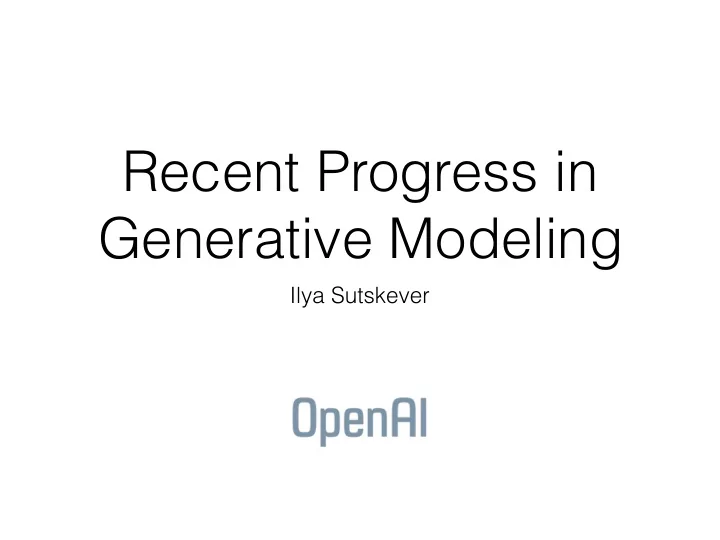

Recent Progress in Generative Modeling Ilya Sutskever
Goal of OpenAI • Make sure that AI is actually good for humanity
Goal of OpenAI • Prevent concentration of AI power • Build AI to benefit as many people as possible • Build AI that will do what we want it to do
ML: what works? • Deep supervised learning • Vision, speech, translation, language, ads, robotics
ML: what works? • Deep supervised learning: • Get lots of input-output examples • Train a very large deep neural network • Convolutional or seq2seq with attention • Great results are likely
What’s next? • Agents that achieve goals • Systems that build a holistic understanding of the world • Creative problem solving • etc
Generative models • Critical for many of the upcoming problems
What is a generative model? • Learn your data distribution • Assign high probability to it • Learn to generate plausible structure • Discover the “true” structure of the data
Generative models • What are they good for? • What can we do with them?
Conventional applications • Good generative models will definitely enable the following: • Structured prediction (e.g., output text) • Much more robust prediction • Anomaly detection • Model-based RL
Speculative applications • Really good feature learning • Exploration in RL • Inverse RL • Good dialog that actually works • “Understanding the world” • Transfer learning
Generative models • Three broad categories of generative models: • Variational Autoencoders • Generative adversarial networks • Autoregressive models
Improved techniques for training GANs • Tim Salimans, Ian Goodfellow, Wojciech Zaremba, Vicki Cheung, Alec Radford, Xi Chen
Generative adversarial networks • A generator G(z) and a discriminator D(x) • Discriminator aims to separate real data from generator samples • Generator tries to fool the discriminator • GANs often produce best samples so far
Generative adversarial networks • Yann LeCun : The most important [recent development], in my opinion, is adversarial training (also called GAN for Generative Adversarial Networks) — from Quora Q&A session
Promising early results • Best high-resolution image samples of any model so far: • Deep generative image models using a Laplacian pyramid of adversarial networks. — Denton et al. • DCGAN — Radford et al.
Hard to train • The model is defined in terms of a minimax problem • No cost function • Hard to tell if progress is being made
Simple ideas for improving GAN training • GANs fail to learn due to the collapse problem : • The generator becomes degenerate and the learning gets stuck • Solution: the discriminator should see the entire mini batch • If all the cases are identical, it will be easier to discern
Results
“Type a quote here.” –Johnny Appleseed
Semi supervised learning with GANs • Semi supervised learning is the problem of getting better classification using unlabelled data • A good generic semi supervised learning algorithm will improve all ML applications
Semi supervised learning with GANs • Discriminator should both tell the class of the training samples, and tell real samples from fake samples apart • The specific way in which it is done is important, but it is technical, and I will not explain it • The GAN training algorithm is also different here. Details are available offline.
Results • MNIST: 50 supervised training cases + ensemble of 10 models = 1.4% test error • CIFAR 10: 4000 supervised training cases = 18.5% test error • Both results are new state of the art
Conclusions • We have better methods for training GANs • New simple way of using GANs to improve discriminative models • New level of sample quality and semi-supervised learning accuracy
InfoGAN • Xi Chen, Rein Houthooft, John Schulman, Ilya Sutskever, Pieter Abbeel
Disentangled representations • Holy grail of representation learning
InfoGAN • Train a GAN • such that: a small subset of its variables is accurately predictable from the generated sample • Straightforward to add this constraint
Actually works!
Exploration with generative models • Rein Houthooft, Xi Chen, John Schulman, Filip De Turck, Pieter Abbeel
The problem • In reinforcement learning, we take random actions • Sometimes the actions do us good • Then we do more of these actions in the future
Exploration • Are random actions the best we can do? • Surely not
Curiosity • Key idea: take actions to maximize “information gain”
Formally • Learn a Bayesian generative model of the environment • For the action taken, calculate the amount of information gained about the environment by the generative model • Add the amount of information to the reward
Actually works • Extremely well on low-D environments • Many unsolvable problems become solvable • Current work: scaling up to high-D environments
Improving Variational Autoencoders with Inverse Autoregressive Flow • Durk Kingma, Tim Salimans, Max Welling
The Helmholtz Machine • Latent variable model • Use an approximate posterior • Maximize a lower bound to the likelihood • Has been impossible to train
Reparameterization Trick • The Helmholtz machine has been forever impossible to train • The reparameterization trick of Kingma and Welling fixes this problem, whenever the latent variables are continuous
High-quality posterior • Approximate posteriors matter • Typical approximate posteriors are very simple • Normal way of doing powerful posteriors is very expensive • IAF = a new cheap way of getting extremely powerful posteriors
Results • Best non-pixel-CNN log probabilities on CIFAR-10 • Excellent samples • Currently training huge ImageNet models
Questions?
Recommend
More recommend